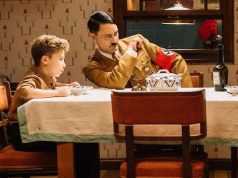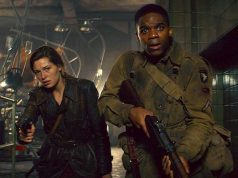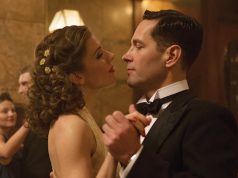The title character of “Fury” is a Sherman tank operated by the U.S. Army at the tail end of World War II, in the heart of Nazi Germany. In addition to the home-field advantage, we’re told the Germans also have more firepower and better war machines than we do. But do they have more pluck and determination? More than the Yanks?! Think again, Jerry!
David Ayer, who has written (and sometimes directed) several films about the L.A.P.D. (“Training Day,” “End of Watch”), smoothly transfers that set of skills to the war genre while focusing on the same themes of brotherhood, loyalty, and righteousness. “Fury” is a compelling, often claustrophobic drama set mainly inside and around the tank as its crew embarks on a routinely perilous mission to take and defend a crossroads. The battle sequences are intense, sometimes brutal, an alarming recreation of the hellishness of war. The in-between scenes aren’t nearly as gripping, but the top-notch performances sustain them.
We meet the Fury crew as they’re being joined by Norman Ellison (Logan Lerman), a squeamish, fresh-faced rookie who’s never seen combat but who does get to see half of the face of the dead gunner he’s replacing, because it’s still in his seat in the tank. (War is gross.) Their leader, sergeant Don “Wardaddy” Collier (Brad Pitt), tells the new kid, “Don’t get too close to anyone” — advice that Wardaddy clearly has not followed himself, as we see from the bond he shares with the other crew members. It’s somewhere between paternal and fraternal, and it may remind you of Aldo Raine in “Inglourious Basterds.”
The others all have nicknames and obvious character traits, too, for easy reference. Boyd “Bible” Swan (Shia LaBeouf) is a bushily mustached Christian who believes the Allies are doing God’s will. Grady “Coon-Ass” Travis is a boisterous Georgia hick. Trini “Gordo” Garcia is a Mexican. God and religion come up a lot in the crew’s tank talk, with Bible’s belief in the divine endorsement of their work shared generally. (Wardaddy notes with irony that under the rules of religion, “We can kill [the Germans], but we can’t f*** ’em.”)
There’s a curious interlude where Wardaddy and Norman pause and play house for a while with two young German women in a newly defeated village. Their hatred of the Nazis does not necessarily extend to the entire German population, though when the other soldiers eventually join the scene, the dynamic between them — especially Wardaddy and Bible, who are often at odds — makes for heady drama. Other dramatic moments in the film don’t fare quite as well, falling more into the category of Standard War Drama. Nothing is bad, but none of it really resonates, either, despite the committed performances from the five leads. It needs another layer.
But it’s the thunderous tank battles that are meant to overwhelm us, not the dramatic dialogues between brothers in arms. “Fury” delivers on that score, the action loud and tense, often hold-your-breath exciting, thanks to Ayer’s un-showy yet effective style. (Roman Vasyanov’s cinematography makes it bleakly pretty to look at, too.) This is where it pays off that Ayer has already established characters, to lend weight to the setbacks and crises the plot will require. When the acts of bravery come — oh, you better believe there are acts of bravery — it’s hard not to feel stirred by the sturdy, well-told story.
B (2 hrs., 14 min.; )
Originally published at GeekNation.





